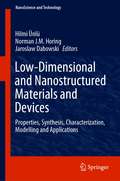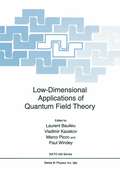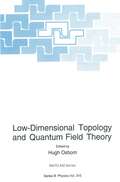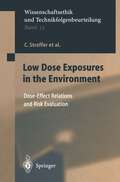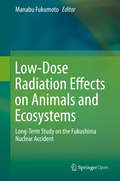- Table View
- List View
Low-Cost Solar Electric Power
by Lewis M. FraasThis book describes recent breakthroughs that promise major cost reductions in solar energy production in a clear and highly accessible manner. The author addresses the three key areas that have commonly resulted in criticism of solar energy in the past: cost, availability, and variability. Coverage includes cutting-edge information on recently developed 40 efficient solar cells, which can produce double the power of currently available commercial cells. The discussion also highlights the potentially transformative emergence of opportunities for integration of solar energy storage and natural gas combined heat and power systems. Solar energy production in the evening hours is also given fresh consideration via the convergence of low cost access to space and the growing number of large terrestrial solar electric power fields around the world.Dr. Fraas has been active in the development of Solar Cells and Solar Electric Power Systems for space and terrestrial applications since 1975. His research team at Boeing demonstrated the first GaAs/GaSb tandem concentrator solar cell in 1989 with a world record energy conversion efficiency of 35 , garnering awards from Boeing and NASA. He has over 30 years of experience at Hughes Research Labs, Chevron Research Co, and the Boeing High Technology Center working with advanced semiconductor devices. In a pioneering paper, he proposed the InGaP/GaInAs/Ge triple junction solar cell predicting a cell terrestrial conversion efficiency of 40 at 300 suns concentration. Having become today’s predominant cell for space satellites, that cell is now entering high volume production for terrestrial Concentrated Photovoltaic (CPV) systems. Since joining JX Crystals, Dr. Fraas has pioneered the development of various thermophotovoltaic (TPV) systems based on the new GaSb infrared sensitive PV cell. Dr. Fraas holds degrees from Caltech (B.Sc. Physics), Harvard (M. A. Applied Physics), and USC (Ph.D. EE).
Low Cycle Fatigue and Elasto-Plastic Behaviour of Materials—3: Volume 3
by K. T. Rie G. König H. W. Grünling P. Neumann H. Nowack K. H. Schwalbe T. SeegerProceeds of the Third International Conference on Low Cycle Fatigue and Elasto-plastic Behaviour of Materials, Berlin Congress Center, Berlin, Germany, 7-11 September 1992
Low Density Lipoproteins
by Charles DayLow density lipoproteins (LDL) are pathophysiologically important be cause of their central role in the disease atherosclerosis and because atherosclerosis is the leading cause of death in developed countries. Many researchers believe that a more detailed knowledge of the struc ture, function, and metabolism of LDL may eventually lead to a means to control atherosclerosis. For this reason a fairly large research effort has gone into the investigation of LDL over the past few years. The purpose of this book is to collect and summarize in one place most of the pub lished information on LDL through 1975. To this end more than 1500 references are cited in the papers that make up this volume. The A, B, C apolipoprotein classification system was adopted for use throughout this work. In addition to the A, B, C, and "D" families of apolipoproteins, apoE is used to designate the "arginine-rich" apolipo protein. This classification system is used because it is far less cumber some than other proposed classification schemes for apolipoproteins.
Low-Dimensional and Nanostructured Materials and Devices: Properties, Synthesis, Characterization, Modelling and Applications (NanoScience and Technology)
by Hilmi Ünlü Norman J. M. Horing Jaroslaw DabowskiThis book focuses on the fundamental phenomena at nanoscale. It covers synthesis, properties, characterization and computer modelling of nanomaterials, nanotechnologies, bionanotechnology, involving nanodevices. Further topics are imaging, measuring, modeling and manipulating of low dimensional matter at nanoscale. The topics covered in the book are of vital importance in a wide range of modern and emerging technologies employed or to be employed in most industries, communication, healthcare, energy, conservation , biology, medical science, food, environment, and education, and consequently have great impact on our society.
Low-Dimensional Applications of Quantum Field Theory (Nato Science Series B: #361)
by L. Baulieu Vladimir Kazakov Marco Picco Paul WindeyThe Cargese Summer School "Low Dimensional Applications of Quantum Field Theory" was held in July 1995. The School was dedicated to the memory of Claude Itzykson. This session focused on the recent progress in quantum field theory in two dimen sions with a particular emphasis on integrable models and applications of quantum field theory to condensed matter physics. A large fraction of the school was also devoted to a detailed review of the exciting developments in four dimensional super symmetric Yang-Mills theory. The diversity of the topics presented constitute, in our opinion, one of the most attractive features of these proceedings. Some contributions constitute a very thor ough introduction to their subject matter and should be helpful to advanced students in the field while others present entirely new research, not previously published, and should be of considerable interest to the specialist. There were in depth introductory lectures on the application of conformal field theory techniques to disordered systems, on the quantum Hall effect, on quantum in tegrable systems, on the thermodynamic Bethe Ansatz and on the new developments in supersymmetric gauges theories. The computation of the three point function of the Liouville model using conformal bootstrap methods was presented in detail.
Low-Dimensional Cooperative Phenomena: The Possibility of High-Temperature Superconductivity (Nato Science Series B: #7)
by H. KellerTheoretical and experimental work on solids with low-dimensi onal cooperative phenomena has been rather explosively expanded in the last few years, and it seems to be quite fashionable to con tribute to this field, especially to the problem of one-dimensional metals. On the whole, one could divide the huge amount of recent investigations into two parts although there is much overlap bet ween these regimes, namely investigations on magnetic exchange interactions constrained to mainly one or two dimensions and, secondly, work done on Id metallic solids or linear chain compounds with Id delocalized electrons. There is, of course, overlap from one extreme case to the other with these solids and in some rare cases both phenomena are studied on one and the same crystal. In fact, however, most of the scientific groups in this area could be associated roughly with one of these categories and,in addition, a separation between theoreticians and experimentalists in each of these groups leads to a further splitting of interests although many theories about these solids have been tested by experimenta lists. Nevertheless, more cooperation and understanding between scientists working on low-dimensional cooperative phenomena should appreciably stimulate further development. With a better inderdis ciplinary understanding, new ideas could possibly help chemists in synthesizing tailor-cut solids. This would in return give experi mentalists new phenomena to examine and finally would stimulate new theoretical work.
Low-Dimensional Cooperative Phenomena: The Possibility of High-Temperature Superconductivity (Nato ASI Subseries B:)
by H. J. KellerLow-Dimensional Electronic Properties of Molybdenum Bronzes and Oxides (Physics and Chemistry of Materials with Low-Dimensional Structures #11)
by C. SchlenkerThe history of low dimensional conductors goes back to the prediction, more than forty years ago, by Peierls, of the instability of a one dimensional metallic chain, leading to what is known now as the charge density wave state. At the same time, Frohlich suggested that an "ideal" conductivity could be associated to the sliding of this charge density wave. Since then, several classes of compounds, including layered transition metal dichalcogenides, quasi one-dimensional organic conduc tors and transition metal tri- and tretrachalcogenides have been extensively studied. The molybdenum bronzes or oxides have been discovered or rediscovered as low dimensional conductors in this last decade. A considerable amount of work has now been performed on this subject and it was time to collect some review papers in a single book. Although this book is focused on the molybdenum bronzes and oxides, it has a far more general interest in the field of low dimensional conductors, since several of the molybdenum compounds provide, from our point of view, model systems. This is the case for the quasi one-dimensional blue bronze, especially due to the availability of good quality large single crystals. This book is intended for scientists belonging to the fields of solid state physics and chemistry as well as materials science. It should especially be useful to many graduate students involved in low dimensional oxides. It has been written by recognized specialists of low dimensional systems.
Low-Dimensional Electronic Systems: New Concepts (Springer Series in Solid-State Sciences #111)
by Guenther Neubauer Friedemar Kuchar Helmut HeinrichOwing to new physical, technological, and device concepts of low-dimensionalelectronic systems, the physics and fabrication of quasi-zero, one- and two-dimensional systems are rapidly growing fields. The contributions presented in this volume cover results of nanostructure fabrication including recently developed techniques, for example, tunneling probe techniques and molecular beam epitaxy, quantum transport including the integer and fractional quantum Hall effect, optical and transport studies of the two-dimensional Wigner solid, phonon studies of low-dimensional systems, and Si/SiGe heterostructures and superlattices. To the readers new in the field this volume gives a comprehensive introduction and for the experts it is an update of their knowledge and a great help for decisions about future research activities.
Low-Dimensional Functional Materials (NATO Science for Peace and Security Series B: Physics and Biophysics)
by Reinhold Egger, Davron Matrasulov and Khamdam RakhimovMaintaining and improving energy security is one of the biggest challenges worldwide. The NATO ARW conference in Tashkent, October 2012, was devoted to discussing visions and concepts that are currently discussed in different research fields. Leading scientists have written concise contributions to introduce the reader to this exciting topic. The present volume summarizes the discussions at the conference.
Low-Dimensional Magnetism
by A.N. Vasiliev O.S. Volkova E.A. Zvereva M.M. MarkinaLow-dimensional magnetism physics involves the search for new magnetic compounds and improving their characteristics to meet the needs of innovative technologies. A comprehensive overview of key materials, their formulation data and characteristics are detailed by the author. Key selling features: Explores dominant mechanisms of magnetic interaction to determine the parameters of exchange interactions in new magnetic materials. Describes how magnetism and superconductivity not only compete, but also "help" each other. Details characteristics of key materials in the magnetic subsystem. Results of several internationally renowned research groups are included and cited. Suitable for a wide range of readers in physics, materials science, and chemistry interested in the problems of the structure of matter.
Low-Dimensional Magnetism
by A.N. Vasiliev O.S. Volkova E.A. Zvereva M.M. MarkinaLow-dimensional magnetism physics involves the search for new magnetic compounds and improving their characteristics to meet the needs of innovative technologies. A comprehensive overview of key materials, their formulation data and characteristics are detailed by the author. Key selling features: Explores dominant mechanisms of magnetic interaction to determine the parameters of exchange interactions in new magnetic materials. Describes how magnetism and superconductivity not only compete, but also "help" each other. Details characteristics of key materials in the magnetic subsystem. Results of several internationally renowned research groups are included and cited. Suitable for a wide range of readers in physics, materials science, and chemistry interested in the problems of the structure of matter.
Low-Dimensional Molecular Metals (Springer Series in Solid-State Sciences #154)
by Naoki Toyota Michael Lang Jens MüllerThis monograph assimilates new research in the field of low-dimensional metals. It provides a detailed overview of the current status of research on quasi-one- and two-dimensional molecular metals, describing normal-state properties, magnetic field effects, superconductivity, and the phenomena of interacting p and d electrons. It includes a number of findings likely to become standard material in future textbooks on solid-state physics.
Low-Dimensional Nanoelectronic Devices: Theoretical Analysis and Cutting-Edge Research
by Angsuman Sarkar Arpan DeyasiProviding cutting-edge research on nanoelectronics and photonic devices and its application in future integrated circuits, this state-of-the-art book tackles the challenges of the different detailed theoretical and analytical models of solving the problems of various nanodevices. The volume also explores from different angles the roles of material composition and choice of materials that now play the most critical role in determining outcomes of low-dimensional nanoelectronic devices. The applications of those findings are extremely beneficial for the computing and telecommunication industries. Beginning with a solid theoretical background for every chapter, this volume covers the hottest areas of present-day electronic engineering. The continuous miniaturization of devices, components, and systems requires corresponding cutting-edge theoretical analysis supported by simulated findings before actual fabrication. That purpose is given maximum focus in this volume, which has interdisciplinary appeal, making it a comprehensive technological volume that deals with underlying aspects of physics, materials, structures in nano-regime, and the corresponding end-product in the form of devices.
Low-Dimensional Nanoelectronic Devices: Theoretical Analysis and Cutting-Edge Research
by Angsuman Sarkar Arpan DeyasiProviding cutting-edge research on nanoelectronics and photonic devices and its application in future integrated circuits, this state-of-the-art book tackles the challenges of the different detailed theoretical and analytical models of solving the problems of various nanodevices. The volume also explores from different angles the roles of material composition and choice of materials that now play the most critical role in determining outcomes of low-dimensional nanoelectronic devices. The applications of those findings are extremely beneficial for the computing and telecommunication industries. Beginning with a solid theoretical background for every chapter, this volume covers the hottest areas of present-day electronic engineering. The continuous miniaturization of devices, components, and systems requires corresponding cutting-edge theoretical analysis supported by simulated findings before actual fabrication. That purpose is given maximum focus in this volume, which has interdisciplinary appeal, making it a comprehensive technological volume that deals with underlying aspects of physics, materials, structures in nano-regime, and the corresponding end-product in the form of devices.
Low Dimensional Semiconductor Structures: Characterization, Modeling and Applications (NanoScience and Technology)
by Hilmi Ünlü and Norman J. M. HoringStarting with the first transistor in 1949, the world has experienced a technological revolution which has permeated most aspects of modern life, particularly over the last generation. Yet another such revolution looms up before us with the newly developed capability to control matter on the nanometer scale. A truly extraordinary research effort, by scientists, engineers, technologists of all disciplines, in nations large and small throughout the world, is directed and vigorously pressed to develop a full understanding of the properties of matter at the nanoscale and its possible applications, to bring to fruition the promise of nanostructures to introduce a new generation of electronic and optical devices. The physics of low dimensional semiconductor structures, including heterostructures, superlattices, quantum wells, wires and dots is reviewed and their modeling is discussed in detail. The truly exceptional material, Graphene, is reviewed; its functionalization and Van der Waals interactions are included here. Recent research on optical studies of quantum dots and on the physical properties of one-dimensional quantum wires is also reported. Chapters on fabrication of nanowire – based nanogap devices by the dielectrophoretic assembly approach. The broad spectrum of research reported here incorporates chapters on nanoengineering and nanophysics. In its presentation of tutorial chapters as well as advanced research on nanostructures, this book is ideally suited to meet the needs of newcomers to the field as well as experienced researchers interested in viewing colleagues’ recent advances.
Low-Dimensional Structures in Semiconductors: From Basic Physics to Applications (Nato Science Series B: #281)
by A. R. Peaker H. G. GrimmeissThis volume contains a sequence of reviews presented at the NATO Advanced Study Institute on 'Low Dimensional Structures in Semiconductors ... from Basic Physics to Applications.' This was part of the International School of Materials Science and 1990 at the Ettore Majorana Centre in Sicily. Technology held in July Only a few years ago, Low Dimensional Structures was an esoteric concept, but now it is apparent they are likely to playa major role in the next generation of electronic devices. The theme of the School acknowledged this rapidly developing maturity.' The contributions to the volume consider not only the essential physics, but take a wider view of the topic, starting from material growth and processing, then prog ressing right through to applications with some discussion of the likely use of low dimensional devices in systems. The papers are arranged into four sections, the first of which deals with basic con cepts of semiconductor and low dimensional systems. The second section is on growth and fabrication, reviewing MBE and MOVPE methods and discussing the achievements and limitations of techniques to reduce structures into the realms of one and zero dimensions. The third section covers the crucial issue of interfaces while the final section deals with devices and device physics.
Low Dimensional Structures Prepared by Epitaxial Growth or Regrowth on Patterned Substrates (NATO Science Series E: #298)
by K. Eberl Pierre M. Petroff Piet DemeesterProceedings of the NATO Advanced Research Workshop, Ringberg in Rottach Egern, Germany, February 20--24, 1995
Low-Dimensional Systems: Interactions and Transport Properties (Lecture Notes in Physics #544)
by Tobias BrandesExperimental progress over the past few years has made it possible to test a n- ber of fundamental physical concepts related to the motion of electrons in low dimensions. The production and experimental control of novel structures with typical sizes in the sub-micrometer regime has now become possible. In parti- lar, semiconductors are widely used in order to con?ne the motion of electrons in two-dimensional heterostructures. The quantum Hall e?ect was one of the ?rst highlights of the new physics that is revealed by this con?nement. In a further step of the technological development in semiconductor-heterostructures, other arti?cial devices such as quasi one-dimensional ‘quantum wires’ and ‘quantum dots’ (arti?cial atoms) have also been produced. These structures again di?er very markedly from three- and two-dimensional systems, especially in relation to the transport of electrons and the interaction with light. Although the technol- ical advances and the experimental skills connected with these new structures are progressing extremely fast, our theoretical understanding of the physical e?ects (such as the quantum Hall e?ect) is still at a very rudimentary level. In low-dimensional structures, the interaction of electrons with one another and with other degrees of freedoms such as lattice vibrations or light gives rise to new phenomena that are very di?erent from those familiar in the bulk ma- rial. The theoretical formulation of the electronic transport properties of small devices may be considered well-established, provided interaction processes are neglected.
Low-Dimensional Systems: Theory, Preparation, and Some Applications (NATO Science Series II: Mathematics, Physics and Chemistry #91)
by Luis M. Liz-Marzán Michael GiersigThis volume contains papers presented at the NATO Advanced Research Workshop (ARW) Dynamic Interactions in Quantum Dot Systems held at Hotel Atrium in Puszczykowo, near Poznan, Poland, May 16-19,2002. The term low-dimensional systems, which is used in the title of this volume, refers to those systems which contain at least one dimension that is intermediate between those characteristic ofatoms/molecules and those ofthe bulk material. Depending on how many dimensions lay within this range, we generally speak of quantum wells, quantum wires, and quantum dots. As such an intermediate state, some properties of low-dimensional systems are very different to those of their molecular and bulk counterparts. These properties generally include optical, electronic, and magnetic properties, and all these are partially covered in this book. The main goal of the workshop was to discuss the actual state of the art in the broad area ofnanotechnology. The initial focus was on the innovative synthesis of nanomaterials and their properties such as: quantum size effects, superparamagnetism, or field emission. These topics lead us into the various field based interactions including plasmon- magnetic spin- and exciton coupling. The newer, more sophisticated methods for characterization of nanomaterials were discussed, as well as the methods for possible industrial applications. In general, chemists and physicists, as well as experts on both theory and experiments on nanosized regime structures were brought together, to discuss the general phenomena underlying their fields ofinterest from different points ofview.
Low-Dimensional Topology and Quantum Field Theory (Nato Science Series B: #315)
by Hugh OsbornThe motivations, goals and general culture of theoretical physics and mathematics are different. Most practitioners of either discipline have no necessity for most of the time to keep abreast of the latest developments in the other. However on occasion newly developed mathematical concepts become relevant in theoretical physics and the less rigorous theoretical physics framework may prove valuable in understanding and suggesting new theorems and approaches in pure mathematics. Such interdis ciplinary successes invariably cause much rejoicing, as over a prodigal son returned. In recent years the framework provided by quantum field theory and functional in tegrals, developed over half a century in theoretical physics, have proved a fertile soil for developments in low dimensional topology and especially knot theory. Given this background it was particularly pleasing that NATO was able to generously sup port an Advanced Research Workshop to be held in Cambridge, England from 6th to 12th September 1992 with the title Low Dimensional Topology and Quantum Field Theory. Although independently organised this overlapped as far as some speak ers were concerned with a longer term programme with the same title organised by Professor M Green, Professor E Corrigan and Dr R Lickorish. The contents of this proceedings of the workshop demonstrate the breadth of topics now of interest on the interface between theoretical physics and mathematics as well as the sophistication of the mathematical tools required in current theoretical physics.
Low Dose Exposures in the Environment: Dose-Effect Relations and Risk Evaluation (Ethics of Science and Technology Assessment #23)
by C. Streffer H. Bolt D. Follesdal P. Hall J.G. Hengstler P. Jacob D Oughton K. Prieß E. Rehbinder E. SwatonLow-Dose Radiation Effects on Animals and Ecosystems: Long-Term Study on the Fukushima Nuclear Accident
by Manabu FukumotoThis open access book summarizes the latest scientific findings regarding the biological effects of the Fukushima Daiichi Nuclear Power Plant (FNPP) accident in 2011.Various cases of changes in animals and organisms have been reported since the FNPP accident. However, it is often unknown whether they are actually due to radiation, since the dose or dose-rate are not necessarily associated with the changes observed. This book brings together the works of radiation biologists and ecologists to provide reliable radioecology data and gives insight into future radioprotection.The book examines the environmental pollution and radiation exposure, and contains valuable data from abandoned livestock in the ex-evacuation zone and from wild animals including invertebrates and vertebrates, aqueous and terrestrial animals, and plants that are subjected to long-term exposure in the area still affected by radiation. It also analyzes dose evaluation, and offers new perspectives gained from the accident, as well as an overview for future studies to promote radioprotection of humans and the ecosystem.Since the biological impact of radiation is influenced by various factors, it is difficult to scientifically define the effects of low-dose/low-dose-rate radiation. However, the detailed research data presented can be combined with the latest scientific and technological advances, such as artificial intelligence, to provide new insights in the future.This book is a unique and valuable resource for researchers, professionals and anyone interested in the impact of exposure to radiation or contamination with radioactive materials.
Low Earth Orbit Satellite Design (Space Technology Library #36)
by George Sebestyen Steve Fujikawa Nicholas Galassi Alex ChuchraIn recent decades, the number of satellites being built and launched into Earth’s orbit has grown immensely, alongside the field of space engineering itself. This book offers an in-depth guide to engineers and professionals seeking to understand the technologies behind Low Earth Orbit satellites.With access to special spreadsheets that provide the key equations and relationships needed for mastering spacecraft design, this book gives the growing crop of space engineers and professionals the tools and resources they need to prepare their own LEO satellite designs, which is especially useful for designers of small satellites such as those launched by universities. Each chapter breaks down the various mathematics and principles underlying current spacecraft software and hardware designs.
Low Electromagnetic Field Exposure Wireless Devices: Fundamentals and Recent Advances
by Masood Ur Rehman Muhammad Ali JamshedLOW ELECTROMAGNETIC FIELD EXPOSURE WIRELESS DEVICES Comprehensive resource covering methods of designing energy efficient and low EMF wireless device techniques Supported with real case studies and recent advancements and laying the foundation for future advancements in the field, Low Electromagnetic Field Exposure Wireless Devices: Fundamentals and Recent Advances describes both ways, i.e. hardware and software, in which the user-centric wireless communication devices can be designed to reduce the levels of EMF to limit the potential long-term effects of EMF on human health. The text covers state-of-the-art and advanced topics such as EMF exposure standards and rationale, EMF evaluation tools, radio resource allocation, energy conservation, energy harvesting, EMF-aware antenna designs, and MIMO, and highlights advancements in this exciting field to date. To aid reader comprehension, the text contains numerous tables, illustrations, and photographs. In Low Electromagnetic Field Exposure Wireless Devices: Fundamentals and Recent Advances, readers can expect to find information on: Fundamentals and key practices, and mechanisms and assessment methods, of exposure to electromagnetic fields The role of the smartphone on the assessment of exposure from 5G and antenna design considerations and techniques for low SAR mobile handsets Numerical exposure assessments of communication systems at higher frequencies and age-dependent exposure estimation using numerical methods Reinforcement learning and device-to-device communication in minimizing EMF exposure and emission-aware uplink resource allocation scheme for non-orthogonal multiple access systems For wireless user equipment designers and hardware engineers, teachers in wireless communications, and postgraduate students in antennas for communication systems, Low Electromagnetic Field Exposure Wireless Devices: Fundamentals and Recent Advances is a must-have resource, covering an important topic that is expected to only grow in significance as future technological developments are made.



